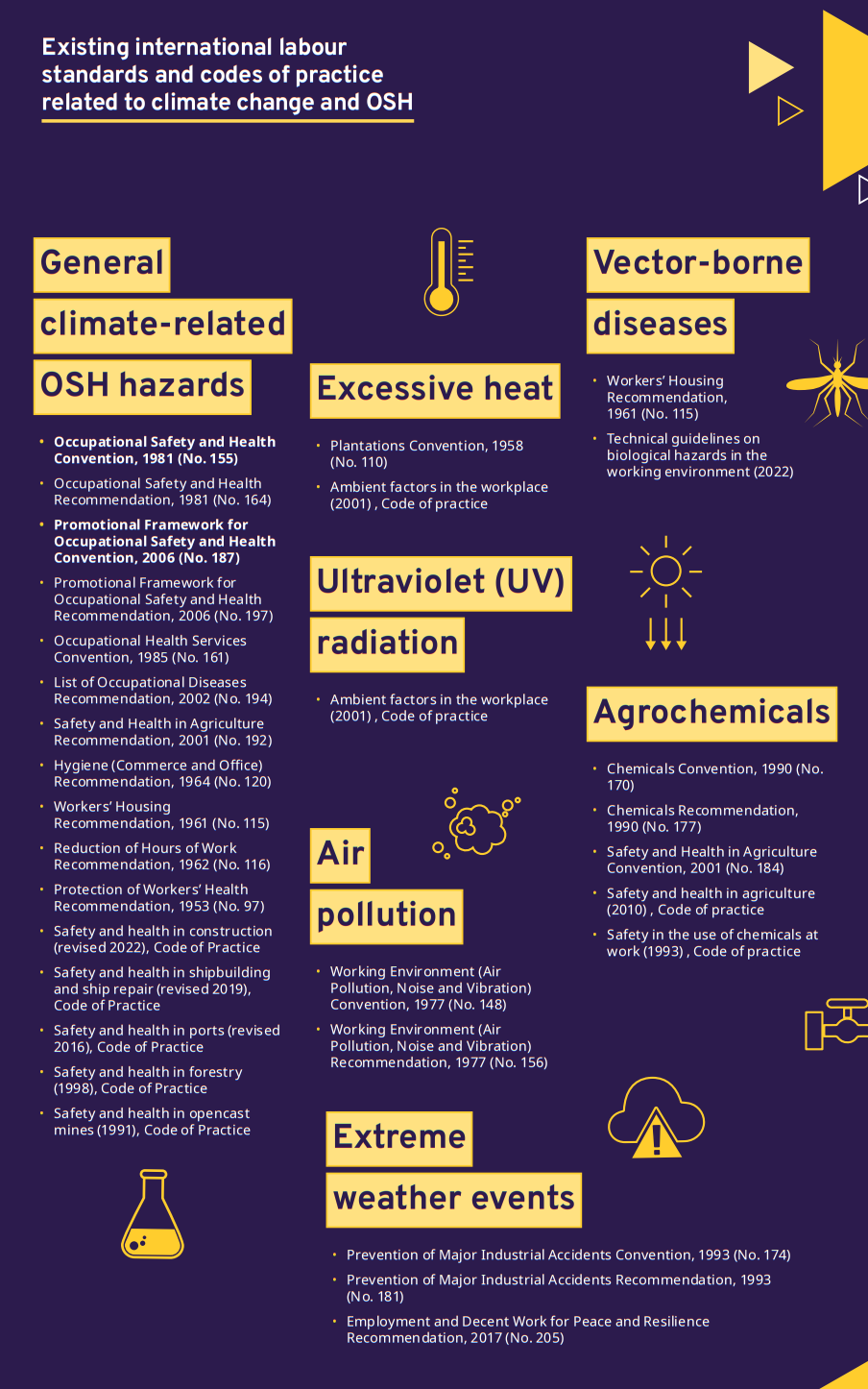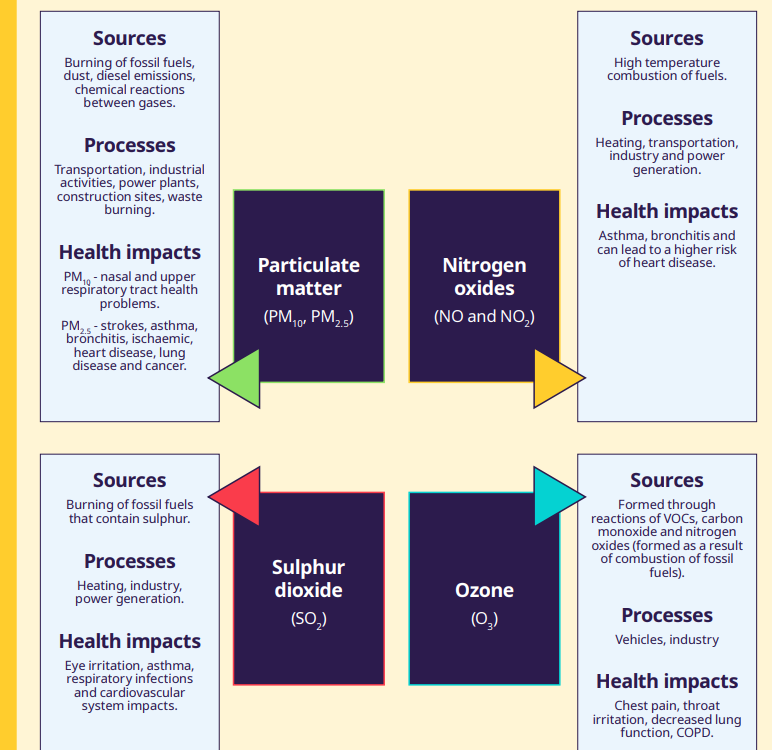Social Issues
Impact of Climate Change on Occupational Safety and Health
- 30 Apr 2024
- 8 min read
For Prelims: International Labour Organization, Occupational safety and health, Extreme weather events, Constitutional Provisions Related to Labour Safety, Occupational Safety, Health, and Working Conditions Code of 2020.
For Mains: Impacts of Climate Change on Occupational Safety and Health.
Why in News?
A recent report by the International Labour Organization (ILO) stated that climate change is significantly affecting occupational safety and health (OSH) worldwide, with workers facing increasing hazards but often having to work in dangerous conditions.
What are the Impacts of Climate Change on Occupational Safety and Health?
| Occupational Hazard | Industries Affected | Health Risks | Impact |
| Excessive Heat Exposure | Agriculture, environmental services, construction, etc. | Heat stress, heatstroke, rhabdomyolysis (muscles break down), cardiovascular diseases, etc. | 2.41 billion workers exposed annually, 22.85 million injuries, 18,970 work-related deaths |
| UV Radiation Exposure | Outdoor work like construction, agriculture, lifeguards, etc. | Sunburn, skin cancers, weakened immune systems, etc. | 1.6 billion workers exposed annually, over 18,960 deaths from non-melanoma skin cancer alone |
| Extreme Weather Events | Emergency workers, construction, agriculture, etc. | Varied risks due to extreme weather events | Many parts of India, Bangladesh, Thailand and Laos saw record-high temperatures in April,2023. |
| Workplace Air Pollution | Outdoor workers, transport workers, firefighters, etc. | Lung cancer, respiratory diseases, cardiovascular diseases | 1.6 billion outdoor workers face increased exposure, 860,000 work-related deaths annually due to air pollution |
|
Vector-Borne Diseases |
Outdoor workers such as farmers, landscapers, construction workers, etc. | Malaria, Lyme disease, dengue, among others | Limited data, over 15,170 work-related deaths each year due to parasitic and vector-borne diseases |
|
Agrochemical Exposure |
Agriculture, chemical industries, forestry, etc. | Poisoning, cancer, neurotoxicity, reproductive disorders, etc. | Significant risk for the 873 million workers in agriculture, over 300,000 deaths annually due to pesticide poisoning |
What are the Provisions Related to Labour Safety in India?
- Constitutional Provisions:
- Concurrent List: Labour is a subject in the Concurrent List where both the Central & State Governments are competent to enact legislation subject to certain matters being reserved for the Centre.
- Entry No. 55 in this list mentions “Regulation of labour and safety in mines and oil fields”.
- Directive Principles of State Policy:
- Article 39(e) of the Constitution emphasises the protection of workers' health, irrespective of gender, and ensures that children are not exploited due to their young age.
- It also aims to prevent individuals from being compelled by economic circumstances to engage in occupations that are not suitable for their physical abilities.
- Article 42 mandates that the State shall make provisions for securing just
- and humane conditions of work and for maternity relief.
- Article 43 outlines the State's responsibility to ensure that all workers, whether in agriculture, industry, or other sectors, receive a wage that allows for a decent standard of living.
- This includes conditions of work that enable a satisfactory quality of life, adequate leisure time, and access to social and cultural opportunities.
- Additionally, the State should work towards promoting cottage industries either individually or cooperatively in rural areas.
- Article 39(e) of the Constitution emphasises the protection of workers' health, irrespective of gender, and ensures that children are not exploited due to their young age.
- Legislative Provisions: The Occupational Safety, Health, and Working Conditions Code of 2020 delineates responsibilities for employers and employees, sets safety standards across sectors, addresses worker health, working hours, and leave policies.
- The Labour Bureau under the Ministry of Labour and Employment in India compiles statistics on industrial accidents and oversees occupational safety.
- International Commitments: India has ratified 47 International Labour Organization conventions along with 1 protocol. Currently, 39 conventions are in force.
- The major conventions related to worker’s health include, the Medical Examination of Young Persons (Sea) Convention, 1921, Equality of Treatment (Accident Compensation) Convention, 1925, Protection Against Accidents (Dockers) Convention (Revised), 1932.
- Concurrent List: Labour is a subject in the Concurrent List where both the Central & State Governments are competent to enact legislation subject to certain matters being reserved for the Centre.
What are the Temperature Limits Related to Workplace in Different Countries?
| Country | Temperature Limits |
| India | Wet Bulb Globe Temperature (WBGT) should not exceed 30°C in factory workrooms |
| China | Work stoppage above 40°C outdoor temperature |
| Singapore | The temperature in working chambers should not exceed 29°C |
| Brazil | Work stoppage above WBGT of 29.4°C for low intensity |
Note:
- The Indian National Disaster Management Authority, along with the Ministry of Home Affairs, issued guidelines for managing heatwaves to safeguard workers.
- These guidelines stress educating workers, ensuring hydration, regulating schedules, and providing medical facilities.
- Special consideration is advised for pregnant workers and those with health issues. Dressing in light, breathable clothing and using umbrellas or hats is recommended.
Way Forward
- Training and Awareness: Providing comprehensive training and awareness programs on climate-related hazards and safety measures can empower workers to identify risks and respond effectively.
- Green Jobs and Sustainable Practices: Promoting green jobs and sustainable practices not only contributes to mitigating climate change but also fosters healthier and safer working environments, such as reducing exposure to harmful substances or emissions.
- Climate-Resilient Policies: Developing and implementing climate-resilient policies and regulations that prioritise worker safety and health in the context of climate change can provide a structured framework for organisations to follow.
- Heat Stress Management: Implementing heat stress management programs, including regular breaks, hydration stations, and access to shaded areas, can protect workers from heat-related illnesses in hotter climates.
- Highly Hazardous Pesticide(HHP) Control: Implementing strict regulations and standards for the production, sale, and use of HHPs. This includes thorough risk assessments before approval, periodic reviews, and bans or phase-outs of particularly hazardous substances.
|
Drishti Mains Question: Examine India's current occupational safety and health framework, highlighting key challenges and suggesting innovative solutions. |
UPSC Civil Services Examination, Previous Year Question (PYQ)
Prelims
Q. Consider the following statements: (2017)
- The Factories Act, 1881 was passed with a view to fix the wages of industrial workers and to allow the workers to form trade unions.
- N.M. Lokhande was a pioneer in organizing the labour movement in British India.
Which of the above statements is/are correct?
(a) 1 only
(b) 2 only
(c) Both 1 and 2
(d) Neither 1 nor 2
Ans: (b)
Mains:
Q. “Success of ‘Make in India’ programme depends on the success of ‘Skill India’ programme and radical labour reforms.” Discuss with logical arguments. (2015)








